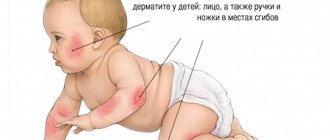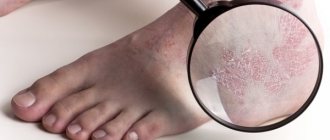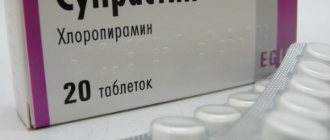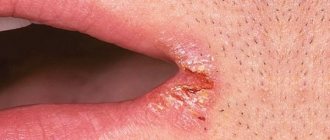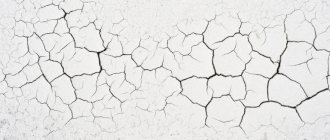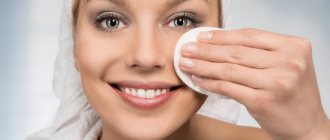Why does my skin peel?
It has been found that dry skin flakes more often than other types. This is due to an insufficient supply of natural moisturizers - oily substances that are produced by the sebaceous glands.
Peeling scales and a feeling of tight skin can be caused by the following reasons:
- Incorrectly selected products for cosmetic care and cleansing of the face and body.
- Allergic reaction to washing powder, fabric softener, dishwashing detergent, cosmetics.
- Taking baths or showers too often.
- Climatic conditions (high air temperature, wind, direct sunlight).
- Dry air in winter.
- Bad habits.
- Insufficient fluid intake.
- Consequences of taking medications.
- Dermatological diseases.
Men also often experience peeling skin on their body or face. The reason for this may be alcohol abuse, smoking addiction and poor diet. Sensitive skin types react to mechanical stress with the appearance of redness and the formation of scales, so rubbing and using harsh cleansers is not recommended.
Dermatological diseases
The pathological processes of the skin that are caused by one or another disease deserve special attention. In this case, it will no longer be possible to remove redness using cosmetics. You will have to contact a dermatologist who will prescribe the appropriate treatment. Redness and peeling of the skin may occur due to the following diseases:
Seborrheic dermatitis
The disease develops due to disruption of sebum secretion processes. Due to excessive secretion formation, the pores on the face become clogged and peeling appears. The composition of sebum may also change, leading to irritation and redness of the epidermis. Seborrheic dermatitis can also develop on the scalp or armpits. Treatment is based on choosing the right skin care. In some cases, patients have to undergo hormonal therapy to normalize the production of skin secretions.
Psoriasis
You can also read: Why red spots on the face flake and itch
A non-infectious disease can appear on the skin of the face, elbows, and knees. Rarely spreads throughout the body. If red plaques appear that are also itchy, you should immediately consult a dermatologist. Psoriasis is a non-standard reaction of the body to external irritants. The disease is considered genetic and practically cannot be completely cured. The therapy is carried out using ultraviolet rays. Cryotherapy also gives good results. Treatment can only be prescribed by a doctor. To avoid relapses, the patient is advised to lead a healthy lifestyle, avoid stress, and use creams to protect against external irritants (sun, wind, frost).
Eczema
Statistics show that 30% of dermatological pathologies are, to one degree or another, a manifestation of this disease. Eczema is a chronic recurrent inflammation of the superficial layers of the epidermis. Most often, redness and itching appears on the palms and soles. The skin may become inflamed on the elbow. Less commonly, the inflammatory process is observed on the face. There are many reasons for the development of eczema. The development of the disease can be triggered by stress, lack of adequate nutrition and rest. Eczema often develops as an allergic reaction to a specific irritant. Treatment of the disease should be comprehensive under the supervision of a qualified dermatologist.
Fungal infections
If the skin turns red, it is possible that you had to deal with one of the types of dermatomycosis. Scientists today know about 500 varieties of fungi that can provoke the development of dermatological pathologies. Treatment of the disease begins with the study of pathogenic microflora and the selection of appropriate antifungal drugs. The most commonly used topical medications are ointments, creams, lotions.
Demodicosis
Skin lesions are caused by microscopic mites. Most often, redness and itching is observed on the skin of the eyelids and around the eyes. The epidermis turns red and begins to peel off. Characteristic is severe itching in the morning, immediately after waking up.
Statistics show that 90% of the world's population is a carrier of a pathogenic microorganism. But the disease begins to manifest itself only after the local immunity has weakened.
Treatment of the disease is quite long. External preparations are used that inhibit the activity of ticks and prevent their reproduction.
Redness and itching of the facial skin may be a symptom of a serious dermatological disease
Is peeling a sign of illness?
This symptom may indicate a developing skin disease. One of these ailments is psoriasis, the spots in which have a pink-red tint, are flaky and itchy. The reasons that trigger the process are currently unknown. The same symptoms include seborrheic and contact dermatitis, pityriasis rosea, lupus erythematosus, scarlet fever (infectious pathology), and fungal infections. Hereditary diseases in which scales form on the skin include ichthyosis. The irritated surface of the dermis does not tolerate the effects of detergents (shampoo, soap, gel), and the unpleasant symptoms intensify.
With a lack of vitamins A and B2, the skin on the forehead, nose and ears peels off greatly, and cracks may appear on the lips. During menopause, many women experience a change in the condition of their outer skin for the worse. This is how the body shows a lack of hormones, especially estrogen. Wrinkles, sagging appear, and skin elasticity is lost. To find out the causes of peeling, you must seek medical help. Specialists in this field are a dermatologist, an allergist, an infectious disease specialist, and a surgeon.
The insidiousness of fungal infections
Basically, fungal infections are concentrated on the feet and toes, and they can quickly spread further along the limb.
People of different ages can contract the infection, but often peeling and dryness of the epidermis occurs precisely as a result of infection by viruses and fungi. The pathology manifests itself between the toes, but it is also possible to observe accompanying signs: peeling of the feet, itching, pain and redness in the areas near the nail plate.
The main reasons why changes in the condition of nails, feet and hands are possible have been identified:
- Weakening of the immune system.
- Wearing shoes that don't fit, and wearing thick socks.
- Poor circulation, mainly in the lower extremities.
- Hormonal imbalance.
- Failures in metabolic processes.
Dried fungi can exist in the dermis for a long time without showing any signs of it. But penetration into a favorable habitat causes microorganisms to rapidly multiply and divide, increasing their numbers several times. They leave residual products of their vital activity on human skin, which is why unpleasant sensations arise: peeling, burning, itching.
A humid environment is the most favorable place for fungal infections to thrive. You can become infected in public places - when visiting baths, saunas, swimming pools.
But all existing factors of the disease are united by a common feature - the symptoms are the same for everyone. At the initial stage of the pathology, peeling between the toes appears, but inaction is fraught with the spread of infection further down the foot.
The main signs of infection of the feet and hands with a fungus
- Cracks.
- Peeling.
- Itching.
- Burning.
- Redness.
- Soreness.
- Dryness.
- In rare cases, bubbles containing liquid form.
A deficiency of vitamins A and B provokes severe peeling not only of the lower extremities, but also of the forehead, nose, ears, and sometimes cracked lips. During menopause, women especially acutely feel the restructuring of the body, which affects it in the worst way. This indicates a lack of estrogen. As a result, sagging, wrinkles appear, and loss of elasticity is observed. The hospital will help you find out what is happening. Elimination of such problems falls within the competence of dermatologists, allergists, surgeons and infectious disease specialists.
The disease progresses rapidly and can enter a new stage at any moment.
Stage | Symptoms |
| Erased | Peeling of the feet, areas between and around the toes. Basically, additional symptoms do not appear, but unbearable itching is rarely possible. |
| Hyperkeratotic | The epidermis becomes denser, cracks become noticeable. In this case, pain, itching, and burning are felt. |
| Dyshidrotic | The foot is covered with blisters containing liquid inside. At a certain point, they form small groups, after which they burst. The skin begins to peel off. Associated symptoms: itching, pain, burning, swelling. |
If the wound is not treated in time, there is a high probability of bacteria and viruses entering this area. Then suppuration forms in place of the bubbly fluid. And the situation is complicated by a jump in temperature - its values increase.
First signs of dry skin
Characteristic signs of dry skin type are:
- Constant feeling of tight skin.
- Matte shade.
- Thin skin.
- Frequent occurrence of redness.
- Itching.
- Peeling.
If your facial skin is dry and flaky, you need to contact a cosmetologist who will select a suitable product to restore water balance. This type of skin is prone to the early appearance of wrinkles, which are not so easy to get rid of, and rapid aging.
Dry skin (xeroderma) can be associated with metabolic disorders in the body and diseases of the thyroid gland. Dead particles, accumulating on the surface of the epidermis, begin to peel off. Dermatitis can cause itching, so first of all you should consult a dermatologist.
In severe cases, very dry skin begins to crack and ulcers appear. This is fraught with infectious contamination.
Causes of peeling skin
- Diseases of internal organs;
- Dry skin type;
- Skin diseases;
- Increased sensitivity of the body;
- Changes in weather and climate;
- Detergents;
- Cosmetics;
- Age;
- Allergy.
Skin type
Dermatologists have found that dry skin is more susceptible to such cosmetic defects. And this is due to the fact that it lacks moisture. Insufficient hydration occurs due to poor functioning of the sebaceous glands. In this case, you can help the body - use moisturizing creams after contact with water and in the winter season, when working batteries make the air warm but dry.
Diseases of the body
As a rule, peeling skin occurs less frequently in men than in women. The cause of peeling is serious chronic or acute diseases of the body. But often such a cosmetic defect is explained simply by the body’s increased sensitivity to external or internal stimuli (sensitization). Skin diseases (psoriasis, seborrheic dermatitis, blepharitis, eczema) are almost always accompanied by peeling. In addition, redness, cracking and itching may also be observed.
In this case, it is better to consult a doctor; only after an examination the doctor can tell what is wrong with you: it could be hormonal disorders, chronic diseases, or even an infection.
Weather and climate
Weather conditions and climate can also provoke peeling. In cold weather, when the air is dry, the skin intensively loses moisture and dries quickly. The same thing happens indoors in winter, during the heating season, when air humidity becomes much lower than optimal for humans. In desert regions, the skin is at risk of dehydration due to prolonged exposure to heat. The northern climate with frost and winds also has an adverse effect on the condition of the skin.
External factors
Every day a person encounters the harmful effects of various external factors in everyday life. For example, hot water during bathing dries out the skin, causing it to peel in the future. Soap and other detergents degrease and dry the epidermis, so it begins to peel off. Dermatologists are also confident that a rough washcloth with intense friction removes the top layer of skin and causes dryness.
Cosmetics have a serious impact on the condition of the epidermis, especially if a woman uses decorative cosmetics daily. Lipstick, eye shadow, mascara, blush, perfume irritate the skin and dry it out. An allergic reaction (contact dermatitis) can be caused by synthetic clothing fabrics and various chemicals that a person encounters in everyday life.
Peeling skin: treatment
Having found the root cause of xeroderma, you can begin to eliminate the symptoms. If the problem is insufficient hydration or rapid evaporation of moisture from the surface, it is necessary to select cosmetics with a high content of fatty components. Medications are used only on the recommendation of a doctor. Such products should contain hydrocortisone (0.5–2%) in the composition.
If the skin on the body is peeling, you need to change the gel and soap. They can give this effect in the first place. It is better to wash your face with clean water or a decoction of medicinal herbs. Cleansing lotions and tonics should not contain alcohol, which causes dryness and tightens the skin.
Possible reasons for an itchy stomach
It is almost impossible to independently determine the cause of itching of the skin of the abdomen and the formation of red spots on it, or without their manifestation. The only exceptions are those cases when a person knows that he has a tendency to be allergic to certain foods, consciously ate them, and local irritation of the epithelium is quite predictable. In other cases, only a specialized specialist can determine the factors for the development of a dermatological disease.
No spots or rashes
The main reasons why the stomach itches without the appearance of spots and rashes are as follows.
Allergy
Itching of the skin of the abdomen without the formation of characteristic red spots or small rashes on its surface occurs with some types of allergic reactions. It can develop as a result of wearing clothes that are made from low-quality synthetic fabrics. Also, if a person has a congenital or acquired allergy to food, he knows about it and continues to eat it without limiting himself in gastronomic preferences. The skin of the abdomen may itch without the formation of a red rash and spots immediately after the patient comes into contact with an external irritant, or after a certain period of time, when allergens accumulate in the blood and epidermal tissues of a person.
Demodicosis
In people leading a clean lifestyle, parasitism of the scabies mite in the surface layer of the epithelium occurs without the appearance of various signs of skin irritation in the form of multiple rashes or red spots. At the same time, the pathogenic activity of the parasite remains at a high level, the scabies mite moves in the epidermal tissues, destroys their structure and provokes a feeling of severe itching.
Fungus
In nature, there are about 300,000 types of fungal infections that can affect human skin. Some types of fungal diseases are characterized by causing redness of the skin, while the presence of others manifests itself only in the form of such a symptom as severe itching. Infection of the skin of the abdomen occurs immediately at the moment of contact of the epithelium with an object or object on which a sufficient number of spores of a fungal infection was present.
With red spots
The reasons why red spots are added to scratching are the following diseases.
Contact dermatitis
It occurs in adults and children who have too sensitive skin surface to external influences of various etiologies. The dermatological disease is characterized by the appearance of multiple red spots on the abdomen. In addition to redness, the patient experiences severe itching of the skin, inflammation and swelling. Pathological symptoms immediately go away as soon as external factors that irritate the skin of the abdomen disappear. In fact, contact dermatitis can be classified as an acute local allergy.
Streptoderma
Streptoderma is a bacterial disease of the skin of the abdomen, which is caused by infection of the epithelium with Staphylococcus aureus or streptococcal infection. Before wound surfaces form, voluminous red spots appear on the epidermal tissues of the abdomen, the diameter of which is about 3-5 centimeters. They always itch very much, and over time they transform into ulcers, from which ichor is released. Inflamed tumors become wet and covered with a dense crust.
Psoriasis
An autoimmune disease of the skin of the abdomen and other parts of the body, which begins its development with the formation of one or several red spots on the epithelium. Sometimes they have a lighter, pink-like hue. The neoplasm is itchy and covered with small scales. Subsequently, the itchy red spot transforms into a psoriatic plaque.
What can a cosmetologist offer?
Beauty salons offer the following procedures to eliminate dry skin:
- Biorevitalization is currently the most popular way to saturate the skin with moisture. Using various techniques (reinforcement, micropapule), hyaluronic acid is introduced, which will start the process of natural collagen formation. The framework, created from hyaluronic acid, collagen and elastin, will retain moisture and help smooth out deep wrinkles.
- Iontophoresis - if dry skin is flaking, then this method can restore water balance and relieve discomfort. The procedure involves treating the skin on which the drug is applied with a low-voltage galvanic current. Active ions transmit a signal to the central nervous system, and the body begins to renew itself.
- Mesotherapy is carried out for various indications: acne, dehydrated skin, wrinkles, rosacea, etc. The drugs are administered by injection and needle-free method (pulse iontophoresis). The goal of the procedure is to increase the activity of fibroblasts. These cells are responsible for the production of elastin and collagen.
Salon procedures can only be performed by specialists with appropriate education (cosmetologists, dermatologists).
How to choose a moisturizer?
Very dry skin on the face and body needs constant and proper care with moisturizing cream, lotion, milk, and tonic. This will help protect the thin epidermis from adverse environmental influences - strong wind, cold air, ultraviolet radiation. Particular attention should be paid to the skin of the hands and face.
Oil-based products perfectly eliminate moisture deficiency. Grape seed oil, almond oil, and shea butter are applied to the face. For washing, it is advisable to use milk, for example, Lait Demaquillant Absolu (Vichy), Natura Siberica. Problem areas on the body where there is flaky skin can be lubricated with olive oil.
Among cosmetic preparations, it is better to give preference to brands that are presented in pharmacies: Vichy (Lipidiose Nutritive), Bioderma (Atoderm). Natural ingredients and proven action through research will help restore freshness, firmness and elasticity to the skin. The disadvantage of such products is their cost, which is much higher than those available in cosmetic stores. When buying a moisturizer, you need to pay attention to the ingredients. The one that contains hyaluronic acid and vitamin E is better suited for the skin. The price will depend on the manufacturer and the naturalness of the ingredients. Sometimes the product may be chosen incorrectly, so it is better to seek advice from a professional cosmetologist or dermatologist.
Facial skin is peeling: what to do at home?
At home, it is quite possible to prepare products that will moisturize dry skin no worse than expensive ready-made preparations. The advantages of folk recipes include the availability of the necessary ingredients, natural origin and confidence in the naturalness of the product.
The most popular homemade skin care products are masks. After the first use, the result will be visible if you take oatmeal (1 tablespoon) steamed with milk and add a spoonful of homemade cream to it. There are also options with honey, butter, and full-fat cottage cheese (with added milk).
A mask with tocopherol (vitamin E) is suitable for dry skin. The price of the solution in the pharmacy is 35-45 rubles. (for 20 ml). Melt cocoa butter (1 tbsp) in a water bath, add 1 tbsp. l. liquid vitamin E and the same amount of sea buckthorn fruit oil. Tocopherol also combines well with lanolin (1:2). The masks are kept on the face for no more than half an hour, after which they are washed off with warm water or using a damp sponge.
Flaky skin? Homemade cream to the rescue!
Vitamin E Recipe
- Brew chamomile (1 tbsp) with boiling water, leave and strain.
- Add half a teaspoon of glycerin to 2 tbsp. l. chamomile decoction.
- Combine the resulting mixture with camphor and castor oil (1 tsp each).
- Finally, add 10 drops of tocopherol solution.
This cream can be stored in the refrigerator for up to 5 days.
Recipe for deep hydration
- Mix the pulp of healing aloe (2 tbsp) with glycerin (0.5 tsp).
- Add a few drops of olive oil.
- Dilute the resulting composition with any essential oil (no more than 7 drops).
Beeswax Recipe
- Coconut oil (3 tbsp) is mixed with clean water (3 tbsp) and a teaspoon of almond oil.
- Beeswax (1 tsp) is melted in a water bath and mixed with the previous ingredients.
- Then add olive oil (2 tablespoons) and half a spoon of borax. During cooking, the ingredients must be stirred constantly.
Nutrition and diet
Peeling skin indicates a lack of useful microelements, vitamins and fluids, which enter the body primarily with food. Therefore, your diet should contain as many healthy foods as possible. Vitamins E, A and B necessary for the epidermis are found in various vegetables and fruits. But you will have to give up fatty meats, lard, smoked meats, canned food, and fatty fermented milk products. In general, it is better to consume meat in minimal quantities, including chicken.
If your facial skin is dry and flaky, it may be lacking vitamin A. In this case, you need to increase the amount of carrots, apricots (dried apricots) and green vegetables in your daily diet. Natural vitamin E is found in nuts, liver, seeds, eggs (they can cause allergies, so you shouldn’t lean on them). A hypoallergenic diet should be followed if the cause of dryness, itching and flaking of the skin is a disease.
Fungus and symptoms of fungal diseases
When the skin of the body is infected by a fungus, peeling may also occur on clearly defined areas of inflammation on the skin. In this case, the symptoms when the fungus is activated on the body can be different, depending on the affected area:
- Arms and legs (palms and feet). In this case, peeling is observed mainly between the fingers. In this case, the skin in these places may even crack. On the palms and soles themselves, the skin becomes much thicker. Bubbles containing liquid contents may form.
- Smooth body skin. If the fungus has affected the body, then spots and plaques can be localized in any part of it. The color of the markings can range from whitish to brown. The spots always peel off and rise somewhat above the healthy dermis.
- Inguinal folds. In this case, bright pink or red spots with a clear outline and a flaky surface may be localized in the inguinal folds, on the buttocks, pubis and inner thighs. Moreover, first a large red spot forms on the body, which, with friction, can grow over large areas of the body.
- Skin on the face . In this case, the fungus appears as purple or red spots located below the mouth, on the neck and chin.
- The scalp. The pathology is more characteristic of children, since the carriers of the fungus are street animals, which children love so much. Gray, yellow-gray lesions with hair falling out on them form in the affected area. The skin itches and flakes.
- Nail fungus (onychomycosis). Here the skin will itch and peel around the affected nail plate, and the nail itself will change its shape, color and structure.
Prevention of dry skin of the face and body
By following some tips and recommendations, you can quickly get rid of problems with dry skin:
- Try to shower no more than 2 times a day.
- Replace soap with cream-based gel.
- Body moisturizers are best applied to damp, clean skin.
- Use a barrier cream if flaky skin appears in winter.
- During the heating season, it is necessary to humidify the air in the house using special devices.
- On hot, sunny days, apply cream with ultraviolet protection to the face.





